Optimizing the Numerical Simulation of the Dust Event of March 2021: Integrating Aerosol Observations through Multi-Scale 3D Variational Assimilation in the WRF-Chem Model
Abstract
:1. Introduction
2. Materials and Methods
2.1. Model and Data
2.2. MS-3DVAR Assimilation
2.3. Assimilation Scheme Design
3. Results
3.1. Observation Analysis
3.2. PM Assimilation Effect Analysis
3.3. AOD Assimilation Effect Analysis
4. Conclusions
Author Contributions
Funding
Data Availability Statement
Conflicts of Interest
References
- Gui, K.; Yao, W.; Che, H.; An, L.; Zheng, Y.; Li, L.; Zhao, H.; Zhang, L.; Zhong, J.; Wang, Y.; et al. Record-Breaking Dust Loading during Two Mega Dust Storm Events over Northern China in March 2021: Aerosol Optical and Radiative Properties and Meteorological Drivers. Atmos. Chem. Phys. 2022, 22, 7905–7932. [Google Scholar] [CrossRef]
- Filonchyk, M.; Peterson, M. Development, Progression, and Impact on Urban Air Quality of the Dust Storm in Asia in March 15–18, 2021. Urban Clim. 2022, 41, 101080. [Google Scholar] [CrossRef]
- Jin, J.; Pang, M.; Segers, A.; Han, W.; Fang, L.; Li, B.; Feng, H.; Lin, H.X.; Liao, H. Inverse Modeling of the 2021 Spring Super Dust Storms in East Asia. Atmos. Chem. Phys. 2022, 22, 6393–6410. [Google Scholar] [CrossRef]
- Zeng, Y.; Wang, M.; Zhao, C.; Chen, S.; Liu, Z.; Huang, X.; Gao, Y. WRF-Chem v3.9 Simulations of the East Asian Dust Storm in May 2017: Modeling Sensitivities to Dust Emission and Dry Deposition Schemes. Geosci. Model Dev. 2020, 13, 2125–2147. [Google Scholar] [CrossRef]
- Nazzal, Y.; Barbulescu, A.; Howari, F.; Yousef, A.; Al-Taani, A.A.; Al Aydaroos, F.; Naseem, M. New Insights on Sand Dust Storm from Historical Records, UAE. Arab. J. Geosci. 2019, 12, 396. [Google Scholar] [CrossRef]
- Gui, K.; Yao, W.; Che, H.; An, L.; Zheng, Y.; Li, L.; Zhao, H.; Zhang, L.; Zhong, J.; Wang, Y.; et al. Two Mega Sand and Dust Storm Events over Northern China in March 2021: Transport Processes, Historical Ranking and Meteorological Drivers. Atmos. Chem. Phys. Discuss. 2021, 1, 36. [Google Scholar]
- Ye, Q.; Zheng, X. Distribution, Transport, and Impact on Air Quality of Two Typical Dust Events in China in 2021. Atmosphere 2023, 14, 432. [Google Scholar] [CrossRef]
- Liang, P.; Chen, B.; Yang, X.; Liu, Q.; Li, A.; Mackenzie, L.; Zhang, D. Revealing the Dust Transport Processes of the 2021 Mega Dust Storm Event in Northern China. Sci. Bull. 2022, 67, 21–24. [Google Scholar] [CrossRef] [PubMed]
- Yasunari, T.J.; Koster, R.D.; Lau, W.K.M.; Kim, K. Impact of Snow Darkening via Dust, Black Carbon, and Organic Carbon on Boreal Spring Climate in the Earth System. J. Geophys. Res. Atmos. 2015, 120, 5485–5503. [Google Scholar] [CrossRef]
- Escribano, J.; Di Tomaso, E.; Jorba, O.; Klose, M.; Gonçalves Ageitos, M.; Macchia, F.; Amiridis, V.; Baars, H.; Marinou, E.; Proestakis, E.; et al. Assimilating Spaceborne Lidar Dust Extinction Improves Dust Forecasts. Atmos. Chem. Phys. Discuss. 2022, 22, 535–560. [Google Scholar] [CrossRef]
- Sokhi, R.S.; Moussiopoulos, N.; Baklanov, A.; Bartzis, J.; Coll, I.; Finardi, S.; Friedrich, R.; Geels, C.; Grönholm, T.; Halenka, T.; et al. Advances in Air Quality Research—Current and Emerging Challenges. Atmos. Chem. Phys. 2022, 22, 4615–4703. [Google Scholar] [CrossRef]
- Carmichael, G.R.; Sandu, A.; Chai, T.; Daescu, D.N.; Constantinescu, E.M.; Tang, Y. Predicting Air Quality: Improvements through Advanced Methods to Integrate Models and Measurements. J. Comput. Phys. 2008, 227, 3540–3571. [Google Scholar] [CrossRef]
- Wang, J.; Zhang, B.; Zhang, H.; Hua, C.; An, L.; Gui, H. Simulation of a Severe Sand and Dust Storm Event in March 2021 in Northern China: Dust Emission Schemes Comparison and the Role of Gusty Wind. Atmosphere 2022, 13, 108. [Google Scholar] [CrossRef]
- Cheng, X.; Liu, Y.; Xu, X.; You, W.; Zang, Z.; Gao, L.; Chen, Y.; Su, D.; Yan, P. Lidar Data Assimilation Method Based on CRTM and WRF-Chem Models and Its Application in PM2.5 Forecasts in Beijing. Sci. Total Environ. 2019, 682, 541–552. [Google Scholar] [CrossRef] [PubMed]
- Li, Z.; Cheng, X.; Gustafson, W.I., Jr.; Vogelmann, A.M. Spectral Characteristics of Background Error Covariance and Multiscale Data Assimilation. Int. J. Numer. Methods Fluids 2016, 82, 1035–1048. [Google Scholar] [CrossRef]
- Wang, Y.; Sartelet, K.N.; Bocquet, M.; Chazette, P. Assimilation of Ground versus Lidar Observations for PM10 Forecasting. Atmos. Chem. Phys. 2013, 13, 269–283. [Google Scholar] [CrossRef]
- Luo, H.; Dong, L.; Chen, Y.; Zhao, Y.; Zhao, D.; Huang, M.; Ding, D.; Liao, J.; Ma, T.; Hu, M.; et al. Interaction between Aerosol and Thermodynamic Stability within the Planetary Boundary Layer during Wintertime over the North China Plain: Aircraft Observation and WRF-Chem Simulation. Atmos. Chem. Phys. 2022, 22, 2507–2524. [Google Scholar] [CrossRef]
- Ha, S.; Kumar, R.; Pfister, G.G.; Lee, Y.; Lee, D.; Kim, H.M.; Ryu, Y.-H. Chemical Data Assimilation with Aqueous Chemistry in WRF-Chem Coupled with WRFDA (V4.4.1). J. Adv. Model. Earth Syst. 2023, 16, e2023MS003928. [Google Scholar] [CrossRef]
- Eltahan, M.; Shokr, M.; Sherif, A. Simulation of Severe Dust Events over Egypt Using Tuned Dust Schemes in Weather Research Forecast (WRF-Chem). Atmosphere 2018, 9, 246. [Google Scholar] [CrossRef]
- Benedetti, A.; Morcrette, J.-J.; Boucher, O.; Dethof, A.; Engelen, R.J.; Fisher, M.; Flentje, H.; Huneeus, N.; Jones, L.; Kaiser, J.W.; et al. Aerosol Analysis and Forecast in the European Centre for Medium-Range Weather Forecasts Integrated Forecast System: 2. Data Assimilation. J. Geophys. Res. Atmos. 2009, 114, 2008JD011115. [Google Scholar] [CrossRef]
- Li, Z.; Zang, Z.; Li, Q.B.; Chao, Y.; Chen, D.; Ye, Z.; Liu, Y.; Liou, K.N. A Three-Dimensional Variational Data Assimilation System for Multiple Aerosol Species with WRF/Chem and an Application to PM2.5 Prediction. Atmos. Chem. Phys. 2013, 13, 4265–4278. [Google Scholar] [CrossRef]
- Vendrasco, E.P.; Sun, J.; Herdies, D.L.; Frederico De Angelis, C. Constraining a 3DVAR Radar Data Assimilation System with Large-Scale Analysis to Improve Short-Range Precipitation Forecasts. J. Appl. Meteorol. Climatol. 2016, 55, 673–690. [Google Scholar] [CrossRef]
- Zang, Z.; You, W.; Ye, H.; Liang, Y.; Li, Y.; Wang, D.; Hu, Y.; Yan, P. 3DVAR Aerosol Data Assimilation and Evaluation Using Surface PM2.5, Himawari-8 AOD and CALIPSO Profile Observations in the North China. Remote Sens. 2022, 14, 4009. [Google Scholar] [CrossRef]
- Bocquet, M.; Elbern, H.; Eskes, H.; Hirtl, M.; Žabkar, R.; Carmichael, G.R.; Flemming, J.; Inness, A.; Pagowski, M.; Pérez Camaño, J.L.; et al. Data Assimilation in Atmospheric Chemistry Models: Current Status and Future Prospects for Coupled Chemistry Meteorology Models. Atmos. Chem. Phys. 2015, 15, 5325–5358. [Google Scholar] [CrossRef]
- Pu, Z.; Kalnay, E. Numerical Weather Prediction Basics: Models, Numerical Methods, and Data Assimilation. In Handbook of Hydrometeorological Ensemble Forecasting; Duan, Q., Pappenberger, F., Thielen, J., Wood, A., Cloke, H.L., Schaake, J.C., Eds.; Springer: Berlin/Heidelberg, Germany, 2018; pp. 1–31. ISBN 978-3-642-40457-3. [Google Scholar]
- Zang, Z.; Liang, Y.; You, W.; Li, Y.; Pan, X.; Li, Z. Multi-Scale Three-Dimensional Variational Data Assimilation for High-Resolution Aerosol Observations: Methodology and Application. Sci. China Earth Sci. 2022, 65, 1961–1971. [Google Scholar] [CrossRef]
- Xie, X.; Myhre, G.; Shindell, D.; Faluvegi, G.; Takemura, T.; Voulgarakis, A.; Shi, Z.; Li, X.; Xie, X.; Liu, H.; et al. Anthropogenic Sulfate Aerosol Pollution in South and East Asia Induces Increased Summer Precipitation over Arid Central Asia. Commun. Earth Environ. 2022, 3, 328. [Google Scholar] [CrossRef]
- Li, J.; Geer, A.J.; Okamoto, K.; Otkin, J.A.; Liu, Z.; Han, W.; Wang, P. Satellite All-Sky Infrared Radiance Assimilation: Recent Progress and Future Perspectives. Adv. Atmos. Sci. 2022, 39, 9–21. [Google Scholar] [CrossRef]
- Yang, T.; Li, H.; Wang, H.; Sun, Y.; Chen, X.; Wang, F.; Xu, L.; Wang, Z. Vertical Aerosol Data Assimilation Technology and Application Based on Satellite and Ground Lidar: A Review and Outlook. J. Environ. Sci. 2023, 123, 292–305. [Google Scholar] [CrossRef]
- Kim, M.; Lee, K.; Lee, Y.H. Visibility Data Assimilation and Prediction Using an Observation Network in South Korea. Pure Appl. Geophys. 2020, 177, 1125–1141. [Google Scholar] [CrossRef]
- Rubin, J.I.; Reid, J.S.; Hansen, J.A.; Anderson, J.L.; Holben, B.N.; Xian, P.; Westphal, D.L.; Zhang, J. Assimilation of AERONET and MODIS AOT Observations Using Variational and Ensemble Data Assimilation Methods and Its Impact on Aerosol Forecasting Skill. J. Geophys. Res. Atmos. 2017, 122, 4967–4992. [Google Scholar] [CrossRef]
- Huang, X.; Ding, A. Aerosol as a Critical Factor Causing Forecast Biases of Air Temperature in Global Numerical Weather Prediction Models. Sci. Bull. 2021, 66, 1917–1924. [Google Scholar] [CrossRef] [PubMed]
- Liu, R.; Lu, Q.; Wu, C.; Ni, Z.; Wang, F. Assimilation of Hyperspectral Infrared Atmospheric Sounder Data of FengYun-3E Satellite and Assessment of Its Impact on Analyses and Forecasts. Remote Sens. 2024, 16, 908. [Google Scholar] [CrossRef]
- Gumber, A.; Reid, J.S.; Holz, R.E.; Eck, T.F.; Hsu, N.C.; Levy, R.C.; Zhang, J.; Veglio, P. Assessment of Severe Aerosol Events from NASA MODIS and VIIRS Aerosol Products for Data Assimilation and Climate Continuity. Atmos. Meas. Tech. 2023, 16, 2547–2573. [Google Scholar] [CrossRef]
- Quan, J.; Tie, X.; Zhang, Q.; Liu, Q.; Li, X.; Gao, Y.; Zhao, D. Characteristics of Heavy Aerosol Pollution during the 2012–2013 Winter in Beijing, China. Atmos. Environ. 2014, 88, 83–89. [Google Scholar] [CrossRef]
- Tsay, S.-C.; Maring, H.B.; Lin, N.-H.; Buntoung, S.; Chantara, S.; Chuang, H.-C.; Gabriel, P.M.; Goodloe, C.S.; Holben, B.N.; Hsiao, T.-C.; et al. Satellite-Surface Perspectives of Air Quality and Aerosol-Cloud Effects on the Environment: An Overview of 7-SEAS/BASELInE. Aerosol Air Qual. Res. 2016, 16, 2581–2602. [Google Scholar] [CrossRef]
- Gao, Z.; Zhou, X. A Review of the CAMx, CMAQ, WRF-Chem and NAQPMS Models: Application, Evaluation and Uncertainty Factors. Environ. Pollut. 2024, 343, 123183. [Google Scholar] [CrossRef]
- Saide, P.E.; Carmichael, G.R.; Liu, Z.; Schwartz, C.S.; Lin, H.C.; Da Silva, A.M.; Hyer, E. Aerosol Optical Depth Assimilation for a Size-Resolved Sectional Model: Impacts of Observationally Constrained, Multi-Wavelength and Fine Mode Retrievals on Regional Scale Analyses and Forecasts. Atmos. Chem. Phys. 2013, 13, 10425–10444. [Google Scholar] [CrossRef]
- Majumdar, S.J.; Sun, J.; Golding, B.; Joe, P.; Dudhia, J.; Caumont, O.; Chandra Gouda, K.; Steinle, P.; Vincendon, B.; Wang, J.; et al. Multiscale Forecasting of High-Impact Weather: Current Status and Future Challenges. Bull. Am. Meteorol. Soc. 2021, 102, E635–E659. [Google Scholar] [CrossRef]
- Ding, Y.; Liang, P.; Liu, Y.; Zhang, Y. Multiscale Variability of Meiyu and Its Prediction: A New Review. J. Geophys. Res. Atmos. 2020, 125, e2019JD031496. [Google Scholar] [CrossRef]
- Gustafsson, N.; Janjić, T.; Schraff, C.; Leuenberger, D.; Weissmann, M.; Reich, H.; Brousseau, P.; Montmerle, T.; Wattrelot, E.; Bučánek, A.; et al. Survey of Data Assimilation Methods for Convective-scale Numerical Weather Prediction at Operational Centres. Q. J. R. Meteorol. Soc. 2018, 144, 1218–1256. [Google Scholar] [CrossRef]
- Wang, D.; You, W.; Zang, Z.; Pan, X.; Hu, Y.; Liang, Y. A Three-Dimensional Variational Data Assimilation System for Aerosol Optical Properties Based on WRF-Chem: Design, Development, and Application of Assimilating Himawari-8 Aerosol Observations. Geosci. Model Dev. 2021, 15, 1821–1840. [Google Scholar] [CrossRef]
- Chen, D.; Liu, Z.; Fast, J.; Ban, J. Simulations of Sulfate-Nitrate-Ammonium (SNA) Aerosols during the extreme haze events over Northern China in October 2014. Atmos. Chem. Phys. 2016, 16, 10707–10724. [Google Scholar] [CrossRef]
- Wang, S.; Dai, T.; Li, C.; Cheng, Y.; Huang, G.; Shi, G. Improving Clear-Sky Solar Power Prediction over China by Assimilating Himawari-8 Aerosol Optical Depth with WRF-Chem-Solar. Remote Sens. 2022, 14, 4990. [Google Scholar] [CrossRef]
- Li, Z.; McWilliams, J.C.; Ide, K.; Farrara, J.D. A Multiscale Variational Data Assimilation Scheme: Formulation and Illustration. Mon. Weather Rev. 2015, 143, 3804–3822. [Google Scholar] [CrossRef]
- Pang, J. The Impacts of Background Error Covariance on Particulate Matter Assimilation and Forecast: An Ideal Case Study with a Modal Aerosol Model over China. Sci. Total Environ. 2021, 786, 147417. [Google Scholar] [CrossRef]
- Liang, Y.; Zang, Z.; Liu, D.; Yan, P.; Hu, Y.; Zhou, Y.; You, W. Development of a Three-Dimensional Variational Assimilation System for Lidar Profile Data Based on a Size-Resolved Aerosol Model in WRF–Chem Model v3.9.1 and Its Application in PM2.5 Forecasts across China. Geosci. Model Dev. 2020, 13, 6285–6301. [Google Scholar] [CrossRef]
- Boylan, J.W.; Russell, A.G. PM and Light Extinction Model Performance Metrics, Goals, and Criteria for Three-Dimensional Air Quality Models. Atmos. Environ. 2006, 40, 4946–4959. [Google Scholar] [CrossRef]
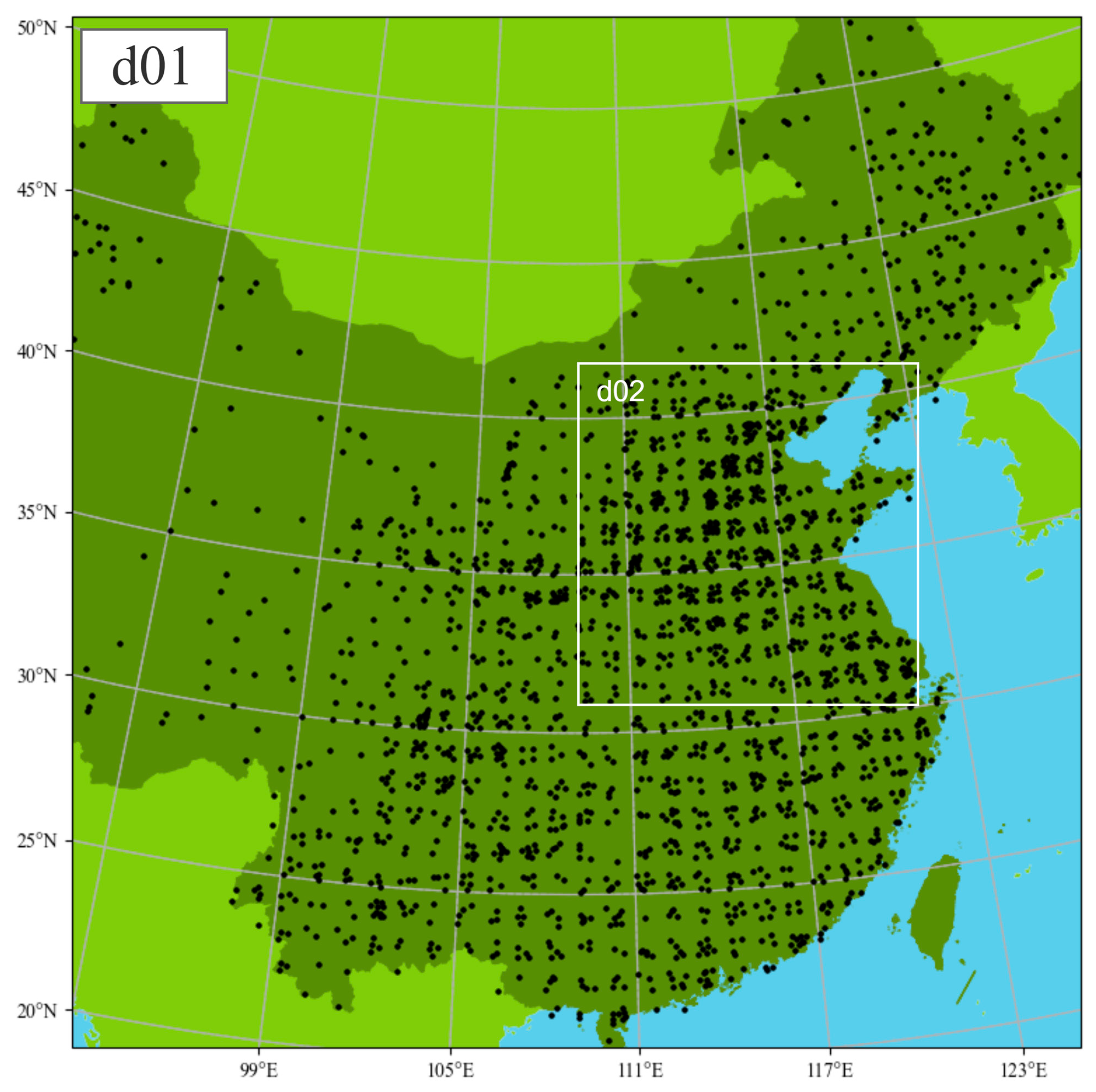
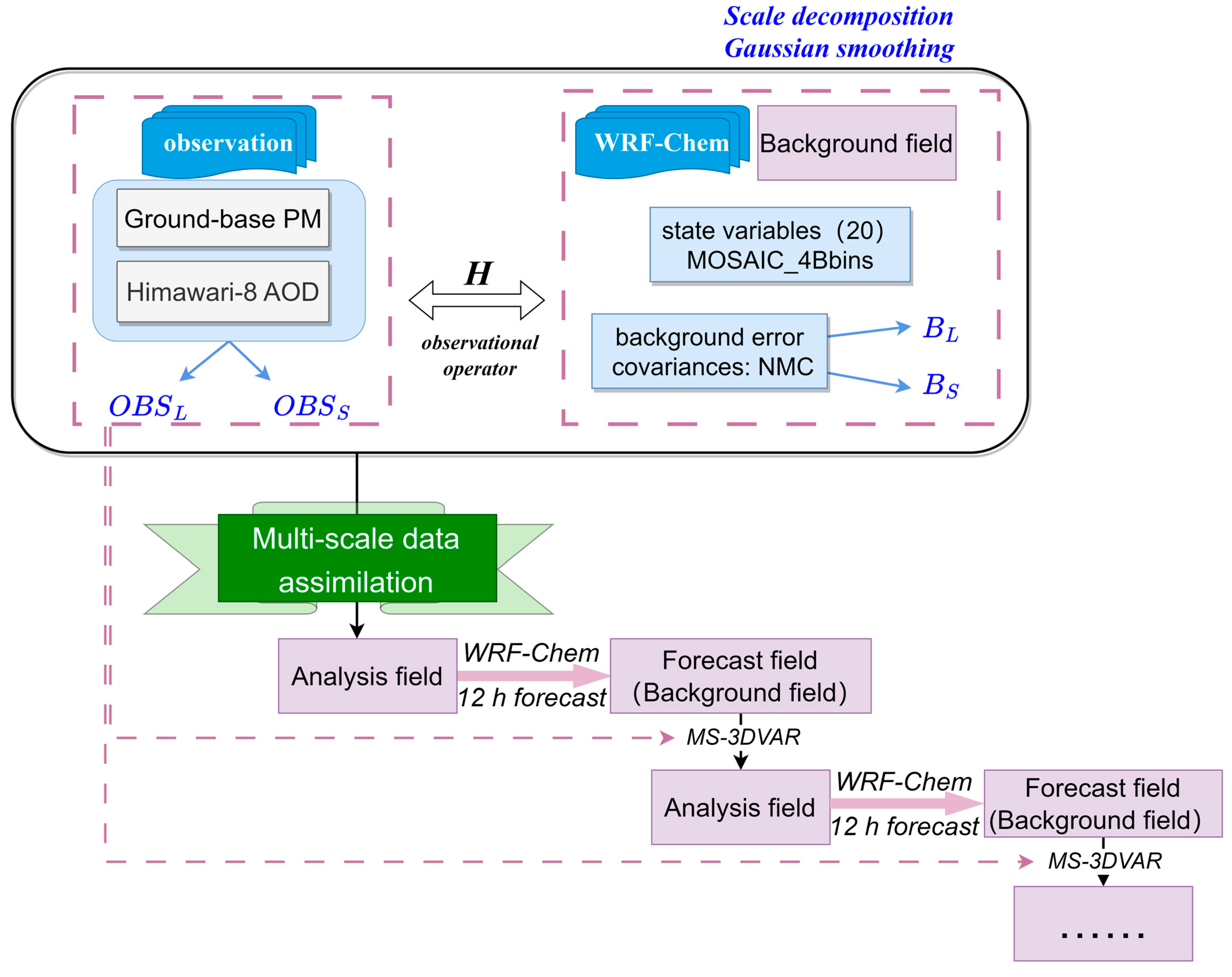
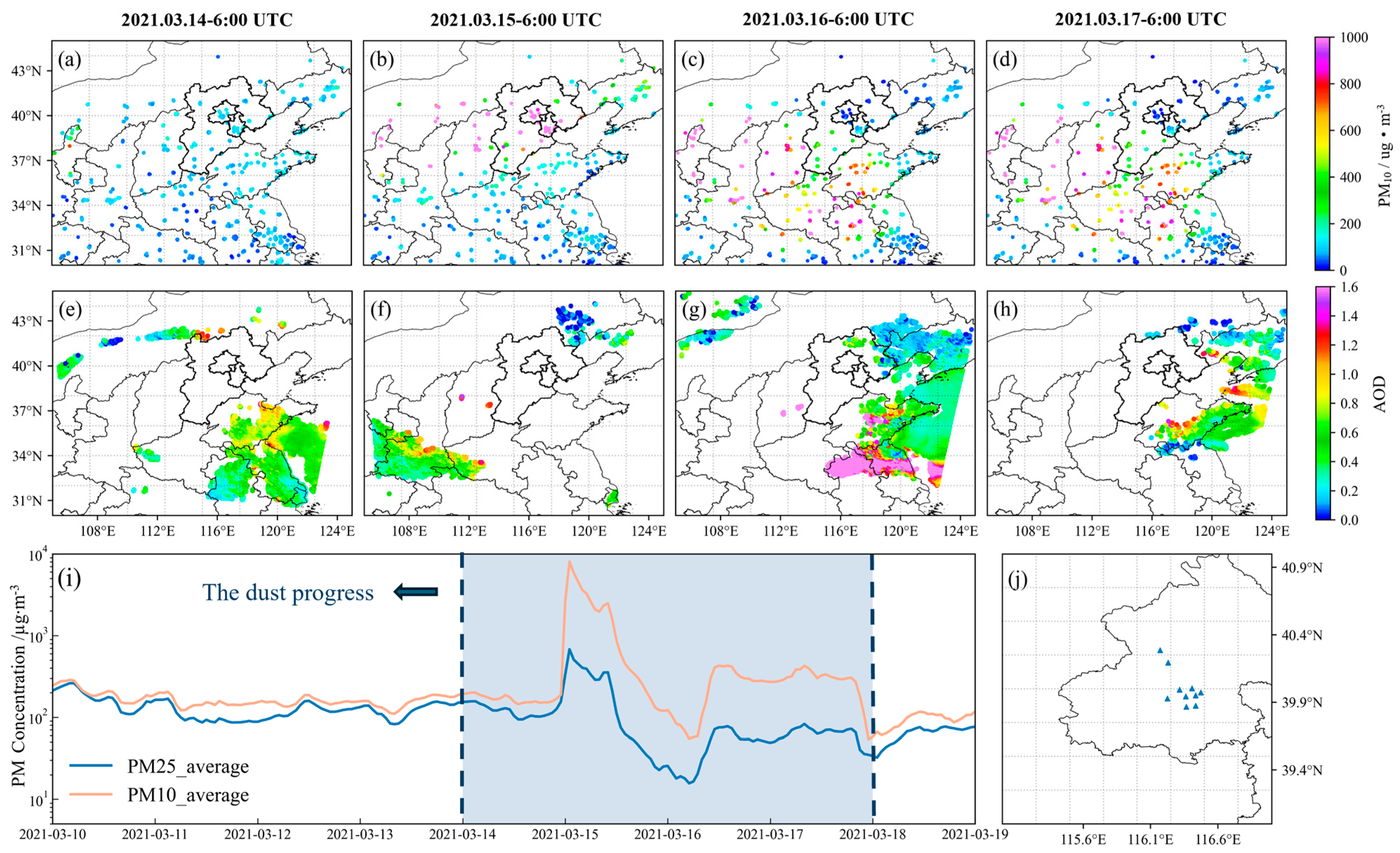
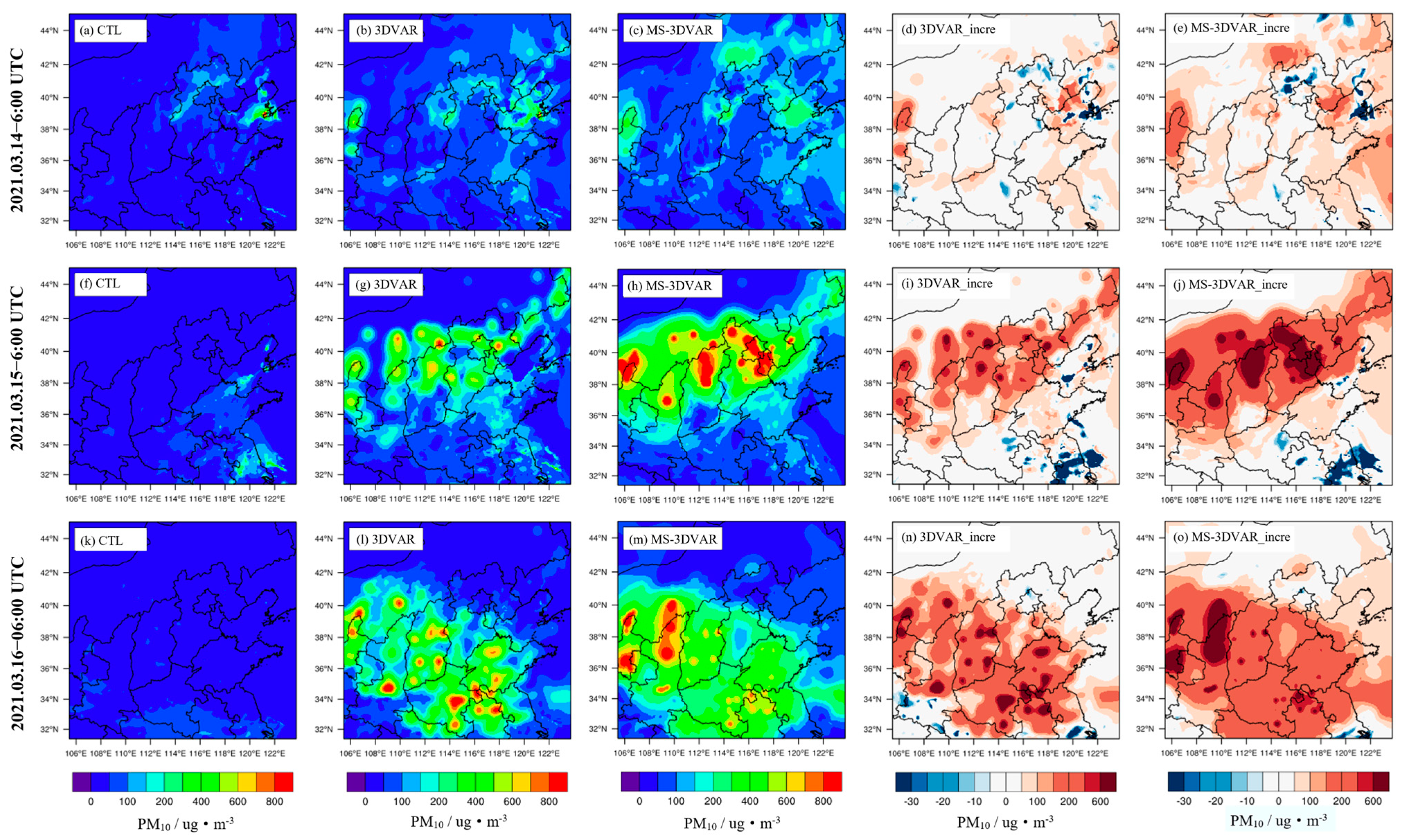
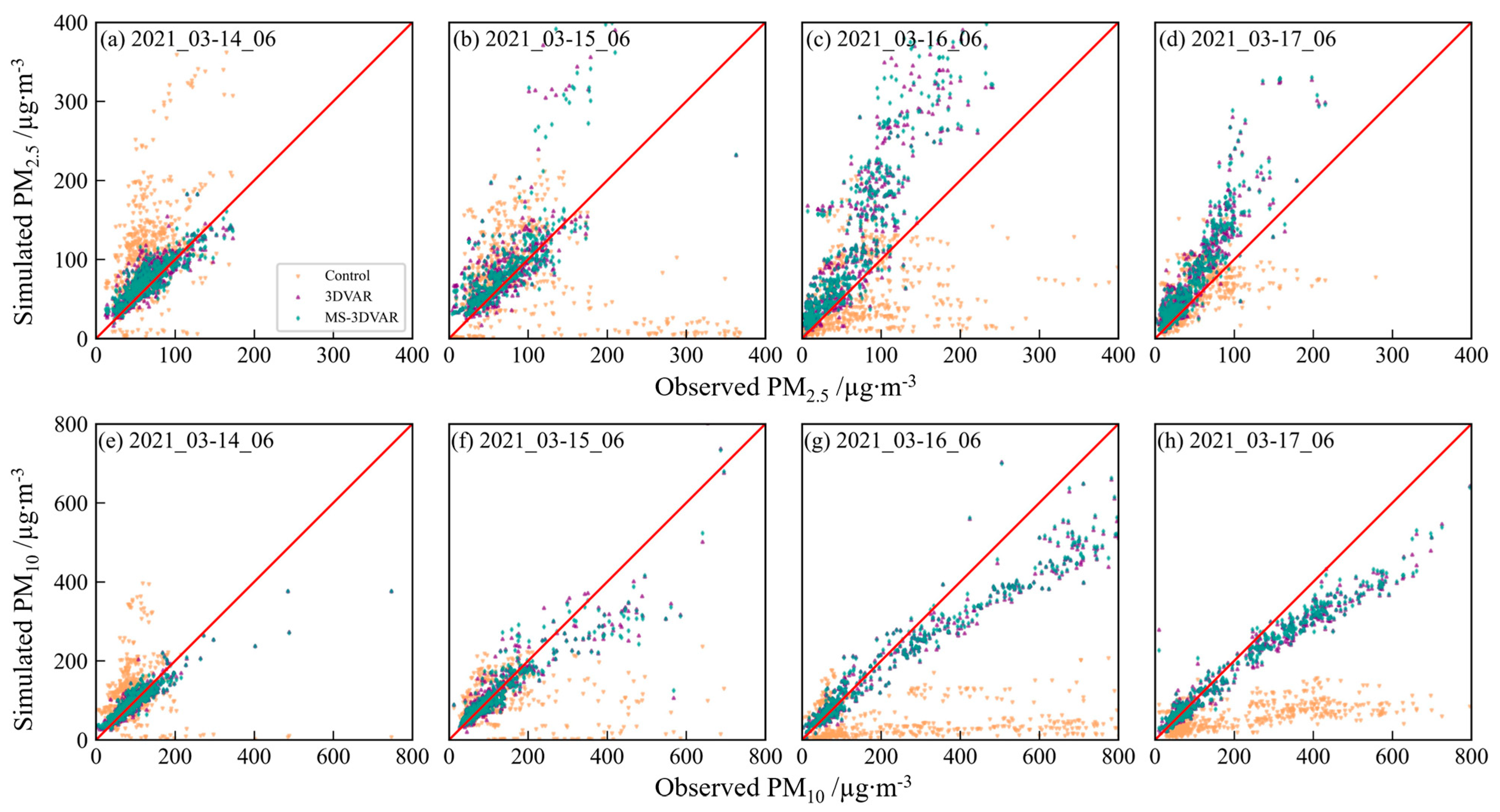
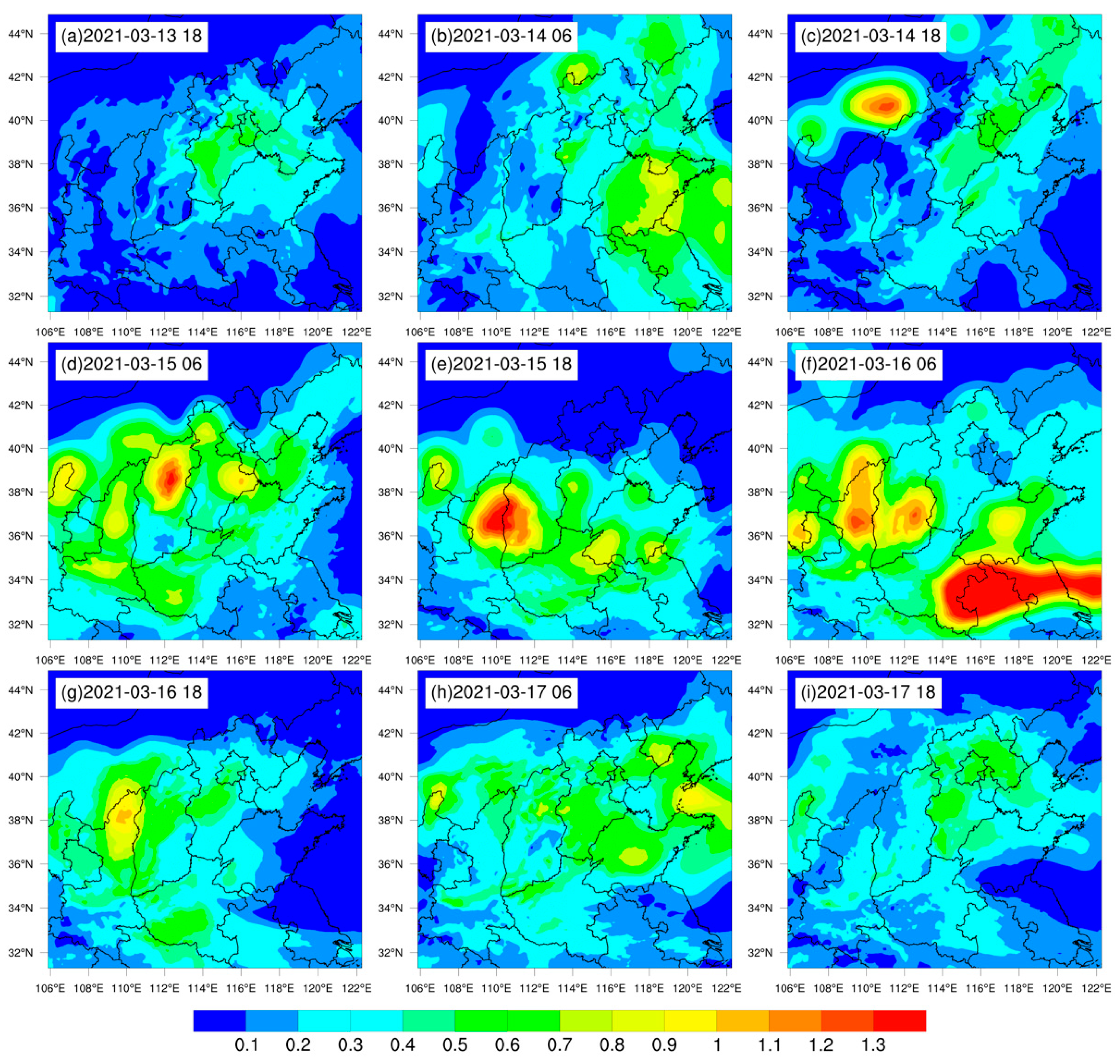

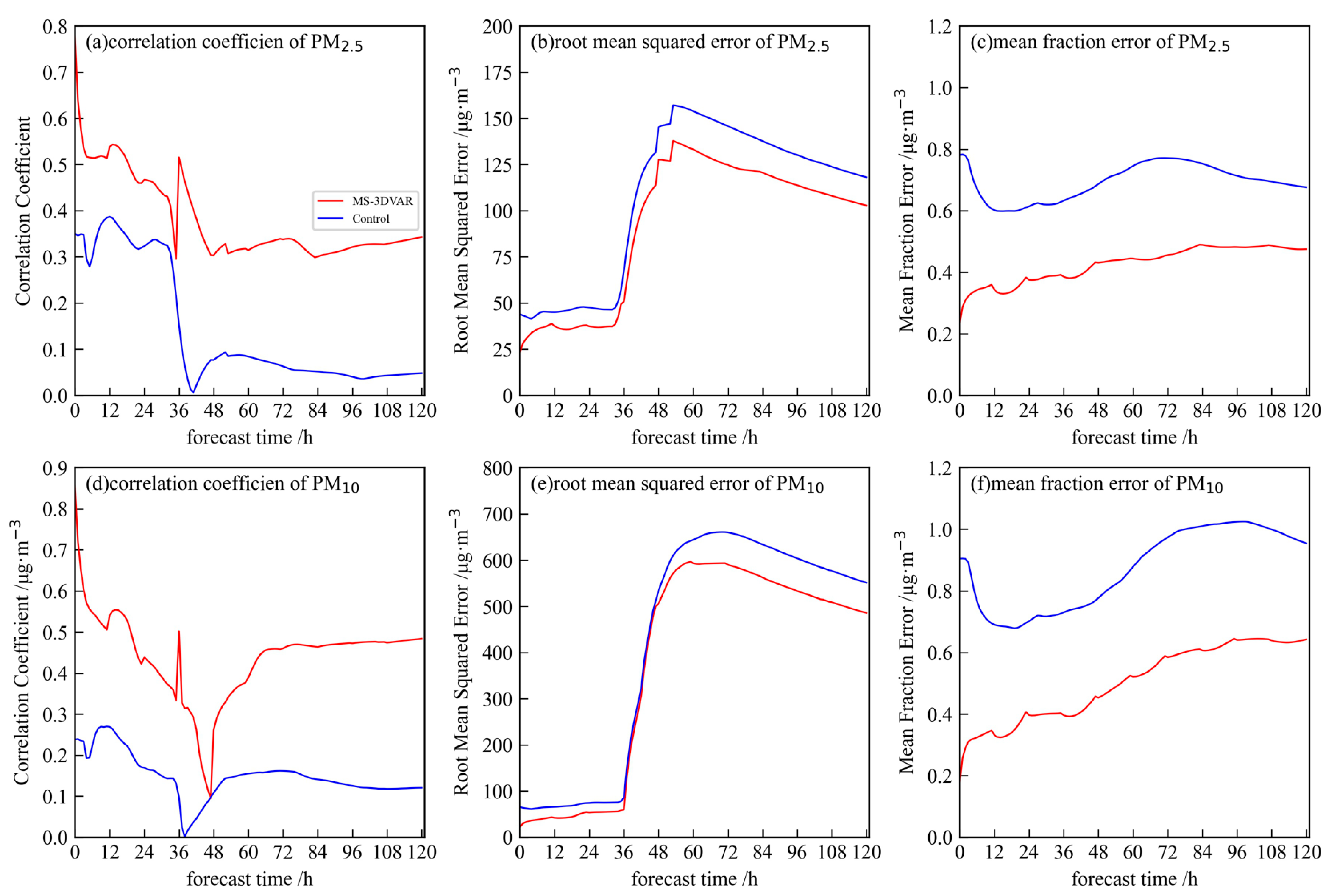

| DATE | Experiment Names | PM2.5 | PM10 | ||||
|---|---|---|---|---|---|---|---|
| CORR | RMSE (µg/m3) | NUM | CORR | RMSE (µg/m3) | NUM | ||
| 03-14 6:00 UTC | Control | 0.46 | 69.111 | 597 | 0.24 | 85.08 | 598 |
| 3DVAR | 0.85 | 16.86 | 0.91 | 32.36 | |||
| MS-3DVAR | 0.88 | 15.85 | 0.93 | 25.30 | |||
| 03-15 6:00 UTC | Control | 0.12 | 253.69 | 577 | 0.42 | 379.67 | 554 |
| 3DVAR | 0.80 | 228.54 | 0.78 | 357.41 | |||
| MS-3DVAR | 0.80 | 224.86 | 0.82 | 348.67 | |||
| 03-16 6:00 UTC | Control | 0.28 | 73.38 | 579 | 0.16 | 595.26 | 574 |
| 3DVAR | 0.72 | 98.25 | 0.76 | 457.41 | |||
| MS-3DVAR | 0.78 | 97.57 | 0.83 | 233.13 | |||
| 03-17 6:00 UTC | Control | 0.55 | 60.22 | 579 | 0.32 | 270.08 | 581 |
| 3DVAR | 0.76 | 55.83 | 0.84 | 92.11 | |||
| MS-3DVAR | 0.79 | 53.15 | 0.85 | 89.74 | |||
Disclaimer/Publisher’s Note: The statements, opinions and data contained in all publications are solely those of the individual author(s) and contributor(s) and not of MDPI and/or the editor(s). MDPI and/or the editor(s) disclaim responsibility for any injury to people or property resulting from any ideas, methods, instructions or products referred to in the content. |
© 2024 by the authors. Licensee MDPI, Basel, Switzerland. This article is an open access article distributed under the terms and conditions of the Creative Commons Attribution (CC BY) license (https://creativecommons.org/licenses/by/4.0/).
Share and Cite
Mei, S.; You, W.; Zhong, W.; Zang, Z.; Guo, J.; Xiang, Q. Optimizing the Numerical Simulation of the Dust Event of March 2021: Integrating Aerosol Observations through Multi-Scale 3D Variational Assimilation in the WRF-Chem Model. Remote Sens. 2024, 16, 1852. https://doi.org/10.3390/rs16111852
Mei S, You W, Zhong W, Zang Z, Guo J, Xiang Q. Optimizing the Numerical Simulation of the Dust Event of March 2021: Integrating Aerosol Observations through Multi-Scale 3D Variational Assimilation in the WRF-Chem Model. Remote Sensing. 2024; 16(11):1852. https://doi.org/10.3390/rs16111852
Chicago/Turabian StyleMei, Shuang, Wei You, Wei Zhong, Zengliang Zang, Jianping Guo, and Qiangyue Xiang. 2024. "Optimizing the Numerical Simulation of the Dust Event of March 2021: Integrating Aerosol Observations through Multi-Scale 3D Variational Assimilation in the WRF-Chem Model" Remote Sensing 16, no. 11: 1852. https://doi.org/10.3390/rs16111852







